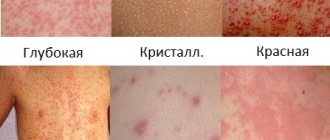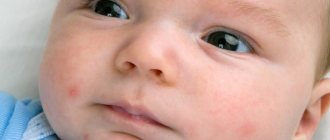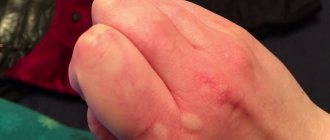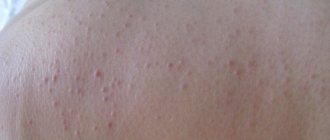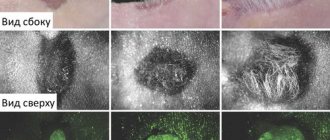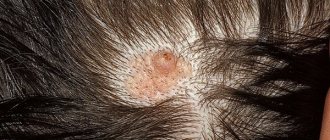The body of infants is susceptible to allergies due to a fragile immune system that instantly reacts to irritating factors. Changes on the skin of a baby's head in the form of flaky areas, rashes, scales, and pimples may be the first signs of an allergic reaction.
If the listed changes are detected, it is necessary to find out the cause of their appearance by consulting a doctor. A specialist will use research to determine whether these changes are an allergic reaction. Timely treatment will prevent unwanted consequences.
Causes of the disease
Allergies to the skin in the scalp area are possible as a result of endocrine diseases, the digestive system, hormonal imbalances and stressful situations.
In addition, the following can provoke the development of dermatitis:
- all kinds of cosmetic products, which include balms, shampoos, various masks used on hair;
- the use of hats made from allergenic material;
- An allergic reaction, especially in a child, can be caused by food. For example, citrus fruits, nuts, seafood, chocolate, etc.;
- in addition, the appearance of a scaly rash and redness can occur due to bad habits, nervous breakdowns, reactions to animal hair, flowering plants, dust, medications;
- in the event of an allergy in a baby, such a rash may be an elementary heat rash, due to the very sensitive and delicate skin of the child. You can often get rid of this problem by frequently rinsing the baby's problem areas with clean water or applying lotions.
There is a certain category of patients whose allergic predisposition is inherited. When parents have an allergy, the likelihood of transmitting this disease to the child increases several times.
It is important to remember that if such manifestations are detected, especially in an infant, it is necessary to urgently consult with your doctor.
Contact dermatitis
Inflammation of the dermis caused by food allergies or exposure to chemicals (non-allergic contact dermatitis).
Itching, rashes, redness, cracked skin on the hands, head or other parts of the body hurts, itches, bleeds in advanced cases. Contact dermatitis can be caused by:
- working with household chemicals without rubber gloves;
- low-quality skin care cosmetics;
- hazardous production or work with chemicals (laboratory technicians).
Treatment of contact dermatitis begins with removing the irritant. Then dermatologists prescribe non-steroidal anti-inflammatory drugs, ointments high in vitamin A, E and B vitamins.
Symptoms of the disease
The main symptom characterizing allergic diseases is itching. At the very beginning of an allergy, there is almost no itching on the head, but as symptoms increase, allergic manifestations become more severe.
Along with itching the following is noted:
- peeling of the skin with the formation of white scales on the surface of the head, resembling dandruff in appearance;
- In addition, skin hyperemia at the site of scratching, thinning and hair loss may appear.
Often, such manifestations of allergies can be triggered by a fungal infection. In this case, the rash may affect the area of the ears and eyebrows.
There is a type of allergy that is characterized by a practically asymptomatic course. The only manifestation of this atypical disease is severe itching in the scalp. Unable to restrain themselves, patients scratch the area of the rash until there are bleeding ulcers, risking introducing painful microflora into the infected wound.
Skin lesions on the head are present in 50% of patients with neurodermatitis. The main category of patients are children. In infants, allergic symptoms manifest themselves differently. In one case, brown scales appear on the baby’s skin, which are commonly called seborrhea. In the second case, red spots and small blisters appear, which subsequently burst and dry out, forming a thin scab on the head.
As a rule, atopic dermatitis occurs with accompanying symptoms. In a child under 3 years of age, the rash may spread to the cheeks. In older children, the rash usually spreads to the neck, face and limbs.
In adult patients, a combination of lesions of the scalp with the face, forearm and décolleté is observed. In the case when itching appears suddenly and does not stop for a long time, this is classified as a manifestation of complications.
Seborrheic eczema
A type of chronic dematosis. Dermatologists detect Pityrosporum ovale on lesions. It is this microorganism that is blamed for the appearance of:
- pinkish-yellowish nodules;
- plaques with large white-yellow scales up to 1 cm;
- rapid hair contamination, unkempt, greasy appearance;
- rapid spread to the scalp, neck and other parts of the body.
Properly selected therapy completely heals the skin, leaving no scars. Dermatologists prescribe sulfur-resorcinol and white mercury ointment, sulfur powder, and salicylic ointment. People take B vitamins internally. Additionally, ultraviolet light and cryotherapy are prescribed for rapid regeneration of the scalp.
Therapeutic measures
Treatment of allergic dermatitis with characteristic rashes on the scalp is usually performed with corticosteroids and non-hormonal anti-inflammatory drugs. The specific choice of drugs depends on the individual characteristics of the patient (age, weight, nature of the rash, severity of symptoms, etc.).
Antihistamines
Once an allergen has been identified, it must be removed from the environment. This condition especially applies to infants. Subsequently, second-generation antiallergy drugs are prescribed. These include:
- Erius;
- Claritin;
- Zodak, etc.
The main difference between these drugs is the minimal number of side effects. The dosage is determined only by the attending physician.
Enterosorbents
To remove toxic substances from the body, especially in children, enterosorbents may be prescribed. These include:
- Enterosgel;
- Polysorb;
- Activated carbon, etc.
Diet
Dietary nutrition is of great importance in the treatment of allergic rashes. The diet must be balanced and developed for each individual patient. For example, if a child or an adult develops allergic itching and other manifestations of the disease due to eating eggs, all products containing eggs and egg powder are prohibited from being used in the diet.
In cases where an allergic disease occurs due to secondary causes, or it is not possible to determine the allergen (especially in a child), it is recommended to keep an allergic food diary, gradually eliminating harmful foods from the daily diet.
Diet adjustments should only be made with the assistance of a physician. Otherwise, general deterioration of the body and skin may occur.
A hypoallergenic diet for rashes on the head consists of consuming approved foods:
| AUTHORIZED PRODUCTS | NOT RECOMMENDED PRODUCTS |
| Lean beef | Alcoholic drinks, eggs |
| Lenten vegetable soups with a small amount of grains | Mayonnaise, mustard, spices, sauce. |
| Boiled potatoes, greens | Nuts, fish products, citrus fruits |
| Butter and refined oil | Confectionery products, chocolate |
| Kefir, cottage cheese, fermented baked milk | Coffee, smoked products, cocoa |
| Rice groats, buckwheat, rolled oats | Radishes, tomatoes, eggplants |
| Baked apple | Dairy products, strawberries |
| Fresh apple compote | Butter pastries |
| Fresh cucumber | Melon watermelon |
| Sugar | Mushrooms |
| Tea | Honey |
It must be remembered that a nursing woman must also adhere to a strict diet until the allergic skin rash is completely removed. After this, a consultation with a nutritionist is necessary, who will conduct a comparative analysis of the patient’s condition and adjust the menu.
Source
As you know, the skin is the largest, heaviest and most multifunctional human organ. In different areas it differs in anatomical and biochemical properties. Many diseases are characterized by a certain localization of rashes.
So, for example, if a rash appears on the head of an adult, the skin itches and peels, this may indicate both a fungal infection and a malfunction of any internal organs, most often the gastrointestinal tract. Let's figure out in what cases a rash appears on the scalp, how to treat it correctly and with what.
Causes of a rash on the head in adults
It is clear that the appearance of a rash on the head of an adult, even if it itches a lot, is far from the only symptom of the disease. When making a diagnosis, the doctor takes into account the entire clinical picture - the patient’s age, the appearance of the rash, test results and medical history.
A rash on the head of an adult may differ in size, color saturation, location, internal contents of papules and pimples.
Among the main reasons why a rash appears on the head of an adult and is very itchy:
- pediculosis - lice feed on human blood, for which they pierce the skin and suck it. It is the moment of puncture that causes severe itching; accordingly, the more lice there are, the more the head itches;
- hormonal imbalance leads to drying of the skin, it begins to peel off, pimples, wounds and cracks appear;
- disruption of the gastrointestinal tract, leading to the appearance of open and closed comedones on the scalp and pustules;
- diabetic neuropathy - the cause of rash and itching is metabolic disorders caused by kidney damage;
- demodex mite (demodex of the scalp) - present in 97% of people, but actively develops only under favorable conditions, as a result of which its waste products greatly irritate the skin, cause itching, burning, and hair loss;
- incorrectly selected hair care products or low-quality medications that cause blockage of the sebaceous glands;
- non-compliance with hygiene rules - rare washing of hair, on the contrary, frequent use of dry shampoos, leading to blockage of hair follicles, etc.;
- cold - when your health worsens, itchy small acne appears, the head and back of the neck itch.
Dry seborrhea
Dry seborrhea occurs for the same reasons as the oily variety, but this disease has its own individual characteristics:
- The main symptom is severe drying of the skin, which leads to flaking of the scalp and the appearance of a large amount of dandruff; its color may vary. Against the background of dandruff formation, severe itching gradually begins to be felt and a general deterioration in the condition of the hair is observed.
- To treat dry seborrhea, complex therapy is used, which will consist of the use of antifungal drugs and shampoos with a moisturizing effect to restore water balance. At the discretion of the specialist, physiotherapeutic procedures may be prescribed, including cryotherapy, mesotherapy or cryomassage. In the most advanced and complex situations, hormonal-type pharmacological medications and medications with high levels of zinc are prescribed.
- Preventive measures are exactly the same as for oily seborrhea.
https://youtube.com/watch?v=8kvatWhZ82U
General clinical manifestations of rash on the scalp
The main complaint that adult patients present with a rash under their hair is itching. Moreover, as a rule, itching occurs first, and only after a new growth occurs - acne, papules, inflammation, ulcers, etc.
Also, most patients experience the following symptoms:
- pain when touching the skin;
- feeling of tightness of the skin under the hair;
- irritation and pimples not only on the hairline, but also on the temples, forehead, behind the ears and on the neck under the hair;
- hyperemia - severe redness of the skin even in uninjured areas.
In the future, depending on the disease, a rash on an adult’s head can behave differently: enlarge or disperse over the entire surface of the scalp, fill with pus and burst, peel off, become crusty, etc.
The situation is aggravated when there is intense heat outside or at home - the skin sweats, becomes even more irritated, and the itching and burning do not even stop.
Teenagers often develop acne and rashes on the scalp. This occurs at the time of the formation of hormonal levels. In women - during menopause and menopause. In men it is much less common, but it can also coincide in time with andropause.
The most important thing is time to see a doctor and prevent complications. Often large pimples, when they break out, leave scars, hair falls out in this place, and does not grow for a long time.
Microsporia
An infectious fungal dermatological disease caused by fungi of the genus Microsporum. It is also called ringworm. The disease affects not only the scalp, but also other parts of the body, including nails. Microsporia is considered the most common disease after foot fungus.
To become infected, it is enough not only to use one towel, but also to walk on the carpet, tiles, or boards in the bathhouse, which a sick person had previously walked on. Or sleep in his bed, wear a hat, cap.
In the area where the fungus has entered, a red spot with clear edges forms near the hair follicle. Its borders are a roller of vesicles, pustules and pustules. The spot quickly grows to the sides, reaching 3 cm in diameter, causing itching and discomfort.
Microsporia is treated with drugs:
- ciclopirox,
- isoconazole,
- bifonazole
Types of rashes on the head
In medical practice, there are more than 100 diseases that cause a rash on the head of an adult and itching. We will name only the most typical ones.
Purulent acne
If a rash on a person’s head looks like large papules filled with pus, this is a sign of bacterial damage caused by staphylococcus. At the first stage, the rash is fragmented. Then the inflammation spreads to the entire follicle, and large painful suppurations begin.
Red rash
A deep pink or red rash in the hair on the head of women may indicate infection with the herpes virus. A complex disease, the treatment of which is complicated by the presence of hair. This, in turn, leads to a worsening of the pathology.
Similar rashes are characteristic of acne syphilide, provoked by Treponema pallidum. The purulent formations of acne syphilide are massive at the time of appearance; after a few days, the rash acquires a red, almost copper color. The acne-like pustule is localized mainly on the scalp and forehead, less often on the back of the head.
It is strictly forbidden to squeeze out ulcers or cover them with brilliant green, iodine, or other ointments and creams. The longer the rash is on the head of an adult, the more it itches, the more the disease worsens and can lead to almost baldness. Any rash on the head is a reason to make an appointment with a dermatologist. It's better to play it safe than to look for a suitable wig later.
Herpetic rashes on the head
The causes of herpes on the head are exactly the same as on all other parts of the body. At the moment the virus invades, the immune system releases specific antibodies that can maintain its activity.
Eosinophilic folliculitis
Disease of unknown origin. The rash reveals a concentration of eosinophils - immune cells in the blood. Folliculitis affects the skin of the upper body. Most often the head, neck. It affects people with weakened immune systems (patients with AIDS, after long-term chemotherapy or with chronic tuberculosis).
The disease manifests itself in the form of painful papules that itch. To alleviate the condition, take corticosteroids and sedatives, monitor hygiene, preventing infection of the wounds.
How to get rid of a rash on your head?
We never tire of repeating that a doctor diagnoses a disease (and a rash on an adult’s head, which also itches, is a disease). This could be a dermatologist, virologist, trichologist and therapist.
Depending on the pathogenesis, appropriate therapy is prescribed:
- If there is a malfunction of the thyroid or thymus gland and general hormonal imbalances, the doctor will prescribe hormonal medications.
- In case of disturbances in the gastrointestinal tract, enterosorbents (Enterosgel, Polysorb, activated carbon) are taken in any case, aimed at ridding the body of harmful substances. Next, the doctor may prescribe hepatoprotectors, enzymes, probiotics and other supportive therapy.
- The herpes virus can be cured with specific antiviral drugs. These include Acyclovir and Famciclovir. Taking immunomodulators at the same time is definitely recommended.
- For bacterial infections, antibiotics are prescribed orally and for external application in the form of ointments or creams.
For a general strengthening effect, you can take vitamin and mineral complexes. This will never be superfluous, especially since the body is currently weakened.
Household lice
Lice infestation is called pediculosis. A person may have head, pubic or body insects. Infection with lice occurs when personal hygiene rules are violated, or poor sanitary conditions (nits (lice eggs) quietly remain in stagnant water for a couple of days (lake, swimming pool, barrel of water)).
Symptoms of pediculosis:
- itching of the head from bites;
- red rashes with a dot in the center (site of the bite);
- inflammation and pustules at the site of scratched bites;
- small strands of hair glued together.
Identifying lice is simple: tilt your head over a white sheet and comb your hair with a thick comb. With head lice, adult insects and their larvae will fall onto a light background. You can also ask a loved one to look at the bite site or the area that itches.
In the old days, lice were removed with kerosene, while cutting the hair of children or adults short. Now the pharmacy is full of special shampoos and sprays for treatment. Repeated treatment is carried out after 10 days to prevent re-infection.
General prevention of rashes on the head
If the papules on the head are not infectious or bacterial in nature, it will be enough to follow the general recommendations to get rid of it:
- regular and proper hygiene;
- treating any rashes, wounds and injuries with antiseptics;
- proper nutrition - less fatty, spicy, fried and salty, more cereals, seasonal fruits and vitamins and water.
Medicinal shampoos
If a rash has already appeared on an adult’s head, it itches and hurts, a simple hypoallergenic baby shampoo will not do. It is advisable to purchase special products containing active antiseptic, anti-inflammatory, antifungal components that affect the skin and hair follicles.
The most popular in this segment are:
- Freederm PH-balance – hypoallergenic shampoo for all hair types for daily use;
- Phyto PhytoCedrat – sebum-regulating shampoo for oily hair on a plant basis;
- Librederm Tar - helps restore the function of the sebaceous glands, accelerates the processes of regeneration of the epidermis, prevents hair loss
- PhytoBioTechnologies Stop Demodex – effectively affects the subcutaneous Demodex mite, relieves irritation, regulates sebum production and prevents changes in its composition, significantly reduces pores;
- Kis KeraScalp Healing – eliminates dandruff, fights bacteria, increases blood circulation in the scalp, suitable for patients suffering from psoriasis and eczema;
- Ecoderm - activates the regenerative and healing processes of the sensitive epidermis, the feeling of itching and unpleasant allergic reaction disappears;
- Cynovit – has powerful antiseptic, antibacterial and moisturizing properties.
Treatment with folk remedies
Along with the use of medications, grandmother’s recipes will not be superfluous. Such measures do not so much treat as they alleviate the patient’s condition, relieve itching and burning:
- From time to time, instead of shampoo, you can use tar soap - the smell, of course, is specific, but the effect is noticeable immediately;
- add a few drops of tea tree oil, liquid vitamins E, A and PP to the shampoo bottle;
- after washing, rinse your hair with a decoction of chamomile, string, oak bark or apple cider vinegar (3 tablespoons per liter of water).
Once a week you can make a mask to get rid of the rash:
- white or blue clay - 2 tbsp;
- burdock oil – 1 tbsp;
- honey – 1 tbsp;
- aloe juice – 1 tbsp;
- water – 2 tbsp.
Mixed, applied to the head and wrapped. Ideally, leave the mask on your head overnight, but if this is not possible, leave it on for at least an hour.

